Food and Beverage Operations Report: Systems, Costs, and Planning
VerifiedAdded on 2020/01/21
|13
|5156
|285
Report
AI Summary
This report examines food and beverage operations within the hospitality sector, focusing on the characteristics of food production and beverage service systems. It explores different methods like conventional, centralized, cook-chill, and convenience methods, along with service systems such as self-service, table service, and buffet systems. The report analyzes factors affecting recipes and menus, including staff skills, customer needs, nutritional aspects, and storage facilities. It compares the cost and staffing implications of various systems, highlighting the suitability of buffet systems for events. Furthermore, the report discusses the use of financial statements in food and beverage operations, including cost statements, operating statements, and variance analysis. It demonstrates the application of cost and pricing processes and provides a framework for menu compilation and service planning, evaluating factors for successful event management.
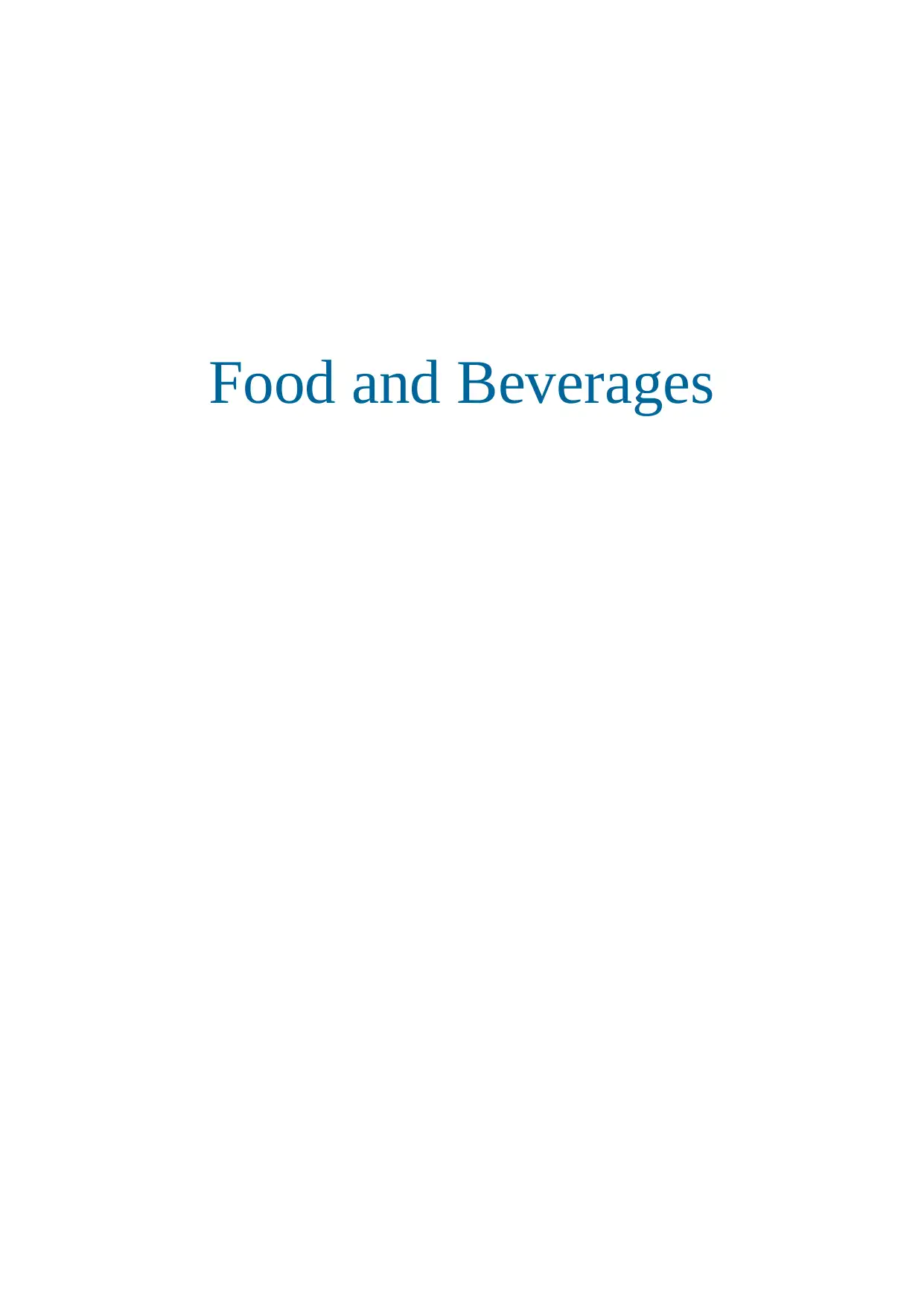
Food and Beverages
Paraphrase This Document
Need a fresh take? Get an instant paraphrase of this document with our AI Paraphraser
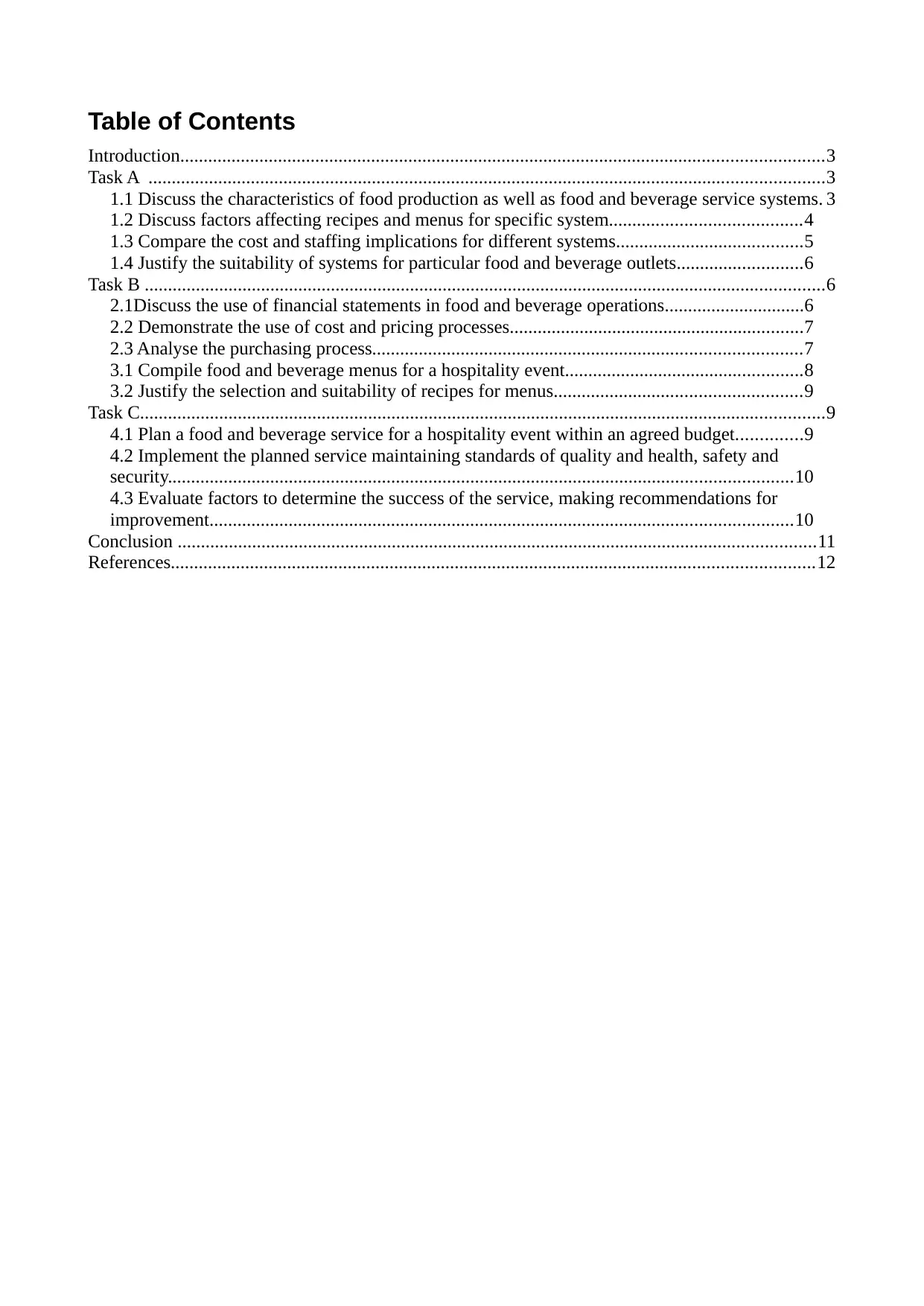
Table of Contents
Introduction..........................................................................................................................................3
Task A .................................................................................................................................................3
1.1 Discuss the characteristics of food production as well as food and beverage service systems. 3
1.2 Discuss factors affecting recipes and menus for specific system.........................................4
1.3 Compare the cost and staffing implications for different systems........................................5
1.4 Justify the suitability of systems for particular food and beverage outlets...........................6
Task B ..................................................................................................................................................6
2.1Discuss the use of financial statements in food and beverage operations..............................6
2.2 Demonstrate the use of cost and pricing processes...............................................................7
2.3 Analyse the purchasing process............................................................................................7
3.1 Compile food and beverage menus for a hospitality event...................................................8
3.2 Justify the selection and suitability of recipes for menus.....................................................9
Task C...................................................................................................................................................9
4.1 Plan a food and beverage service for a hospitality event within an agreed budget..............9
4.2 Implement the planned service maintaining standards of quality and health, safety and
security......................................................................................................................................10
4.3 Evaluate factors to determine the success of the service, making recommendations for
improvement.............................................................................................................................10
Conclusion .........................................................................................................................................11
References..........................................................................................................................................12
Introduction..........................................................................................................................................3
Task A .................................................................................................................................................3
1.1 Discuss the characteristics of food production as well as food and beverage service systems. 3
1.2 Discuss factors affecting recipes and menus for specific system.........................................4
1.3 Compare the cost and staffing implications for different systems........................................5
1.4 Justify the suitability of systems for particular food and beverage outlets...........................6
Task B ..................................................................................................................................................6
2.1Discuss the use of financial statements in food and beverage operations..............................6
2.2 Demonstrate the use of cost and pricing processes...............................................................7
2.3 Analyse the purchasing process............................................................................................7
3.1 Compile food and beverage menus for a hospitality event...................................................8
3.2 Justify the selection and suitability of recipes for menus.....................................................9
Task C...................................................................................................................................................9
4.1 Plan a food and beverage service for a hospitality event within an agreed budget..............9
4.2 Implement the planned service maintaining standards of quality and health, safety and
security......................................................................................................................................10
4.3 Evaluate factors to determine the success of the service, making recommendations for
improvement.............................................................................................................................10
Conclusion .........................................................................................................................................11
References..........................................................................................................................................12
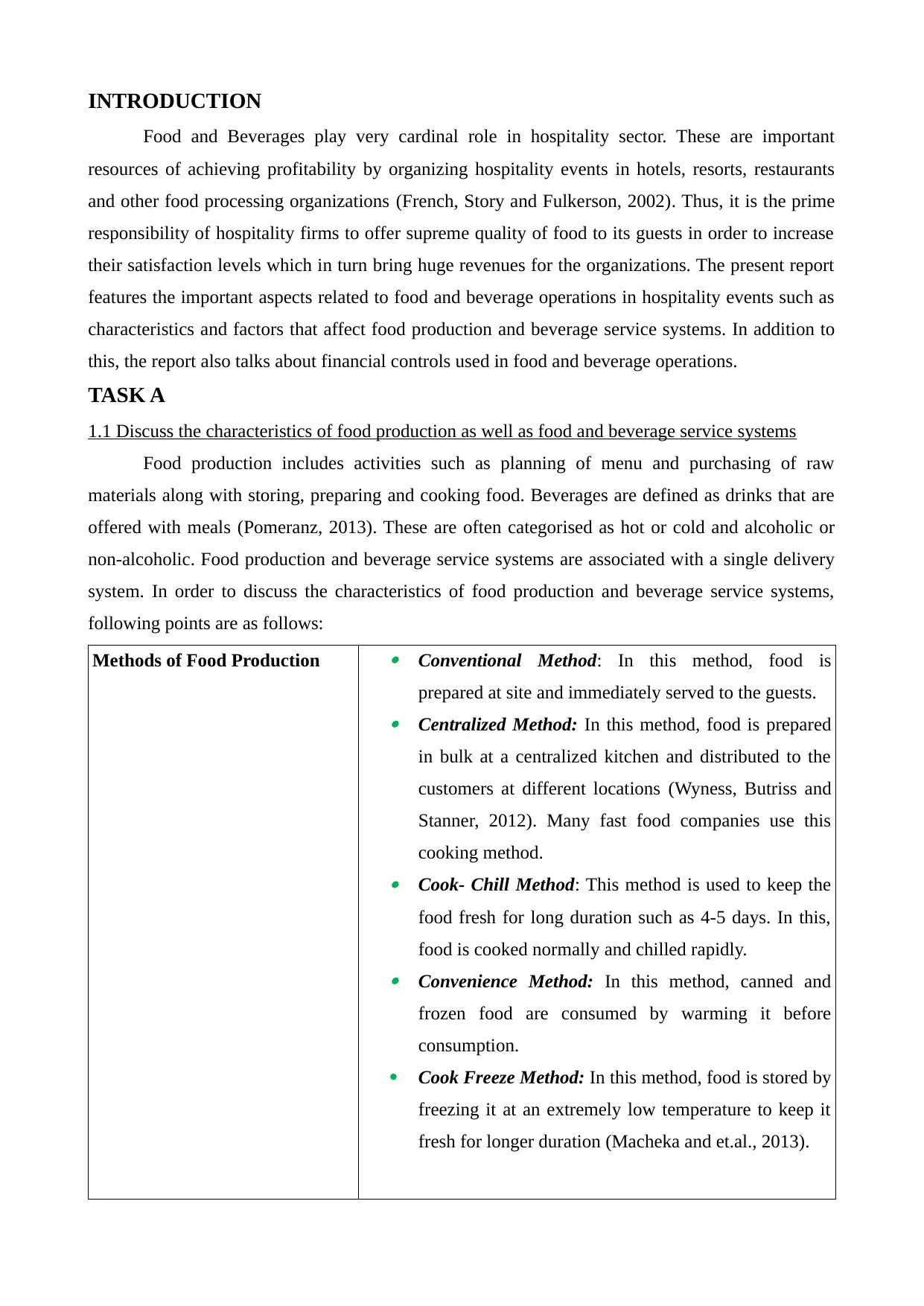
INTRODUCTION
Food and Beverages play very cardinal role in hospitality sector. These are important
resources of achieving profitability by organizing hospitality events in hotels, resorts, restaurants
and other food processing organizations (French, Story and Fulkerson, 2002). Thus, it is the prime
responsibility of hospitality firms to offer supreme quality of food to its guests in order to increase
their satisfaction levels which in turn bring huge revenues for the organizations. The present report
features the important aspects related to food and beverage operations in hospitality events such as
characteristics and factors that affect food production and beverage service systems. In addition to
this, the report also talks about financial controls used in food and beverage operations.
TASK A
1.1 Discuss the characteristics of food production as well as food and beverage service systems
Food production includes activities such as planning of menu and purchasing of raw
materials along with storing, preparing and cooking food. Beverages are defined as drinks that are
offered with meals (Pomeranz, 2013). These are often categorised as hot or cold and alcoholic or
non-alcoholic. Food production and beverage service systems are associated with a single delivery
system. In order to discuss the characteristics of food production and beverage service systems,
following points are as follows:
Methods of Food Production
Conventional Method: In this method, food is
prepared at site and immediately served to the guests.
Centralized Method: In this method, food is prepared
in bulk at a centralized kitchen and distributed to the
customers at different locations (Wyness, Butriss and
Stanner, 2012). Many fast food companies use this
cooking method.
Cook- Chill Method: This method is used to keep the
food fresh for long duration such as 4-5 days. In this,
food is cooked normally and chilled rapidly.
Convenience Method: In this method, canned and
frozen food are consumed by warming it before
consumption.
Cook Freeze Method: In this method, food is stored by
freezing it at an extremely low temperature to keep it
fresh for longer duration (Macheka and et.al., 2013).
Food and Beverages play very cardinal role in hospitality sector. These are important
resources of achieving profitability by organizing hospitality events in hotels, resorts, restaurants
and other food processing organizations (French, Story and Fulkerson, 2002). Thus, it is the prime
responsibility of hospitality firms to offer supreme quality of food to its guests in order to increase
their satisfaction levels which in turn bring huge revenues for the organizations. The present report
features the important aspects related to food and beverage operations in hospitality events such as
characteristics and factors that affect food production and beverage service systems. In addition to
this, the report also talks about financial controls used in food and beverage operations.
TASK A
1.1 Discuss the characteristics of food production as well as food and beverage service systems
Food production includes activities such as planning of menu and purchasing of raw
materials along with storing, preparing and cooking food. Beverages are defined as drinks that are
offered with meals (Pomeranz, 2013). These are often categorised as hot or cold and alcoholic or
non-alcoholic. Food production and beverage service systems are associated with a single delivery
system. In order to discuss the characteristics of food production and beverage service systems,
following points are as follows:
Methods of Food Production
Conventional Method: In this method, food is
prepared at site and immediately served to the guests.
Centralized Method: In this method, food is prepared
in bulk at a centralized kitchen and distributed to the
customers at different locations (Wyness, Butriss and
Stanner, 2012). Many fast food companies use this
cooking method.
Cook- Chill Method: This method is used to keep the
food fresh for long duration such as 4-5 days. In this,
food is cooked normally and chilled rapidly.
Convenience Method: In this method, canned and
frozen food are consumed by warming it before
consumption.
Cook Freeze Method: In this method, food is stored by
freezing it at an extremely low temperature to keep it
fresh for longer duration (Macheka and et.al., 2013).
⊘ This is a preview!⊘
Do you want full access?
Subscribe today to unlock all pages.

Trusted by 1+ million students worldwide
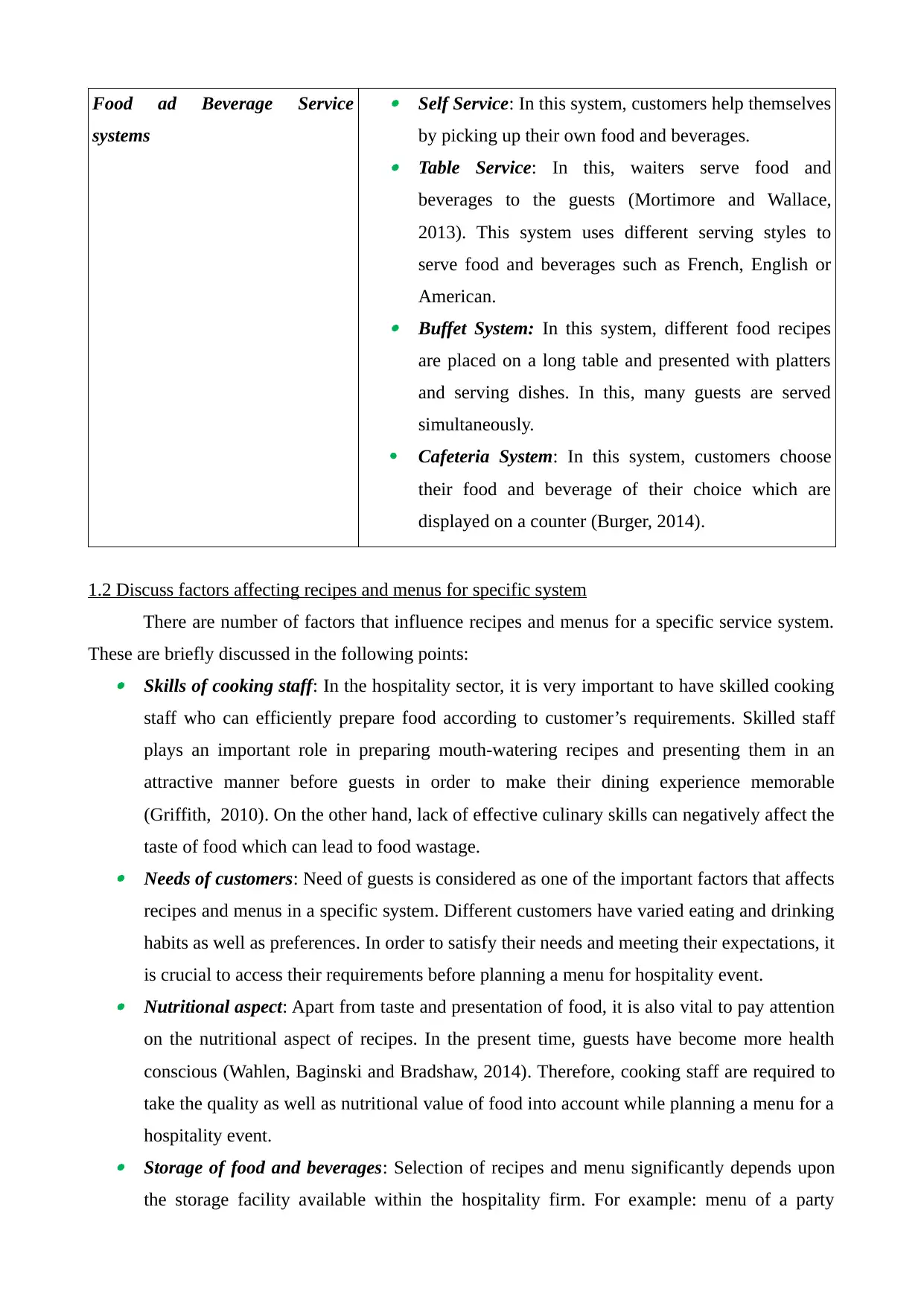
Food ad Beverage Service
systems
Self Service: In this system, customers help themselves
by picking up their own food and beverages.
Table Service: In this, waiters serve food and
beverages to the guests (Mortimore and Wallace,
2013). This system uses different serving styles to
serve food and beverages such as French, English or
American.
Buffet System: In this system, different food recipes
are placed on a long table and presented with platters
and serving dishes. In this, many guests are served
simultaneously.
Cafeteria System: In this system, customers choose
their food and beverage of their choice which are
displayed on a counter (Burger, 2014).
1.2 Discuss factors affecting recipes and menus for specific system
There are number of factors that influence recipes and menus for a specific service system.
These are briefly discussed in the following points: Skills of cooking staff: In the hospitality sector, it is very important to have skilled cooking
staff who can efficiently prepare food according to customer’s requirements. Skilled staff
plays an important role in preparing mouth-watering recipes and presenting them in an
attractive manner before guests in order to make their dining experience memorable
(Griffith, 2010). On the other hand, lack of effective culinary skills can negatively affect the
taste of food which can lead to food wastage. Needs of customers: Need of guests is considered as one of the important factors that affects
recipes and menus in a specific system. Different customers have varied eating and drinking
habits as well as preferences. In order to satisfy their needs and meeting their expectations, it
is crucial to access their requirements before planning a menu for hospitality event. Nutritional aspect: Apart from taste and presentation of food, it is also vital to pay attention
on the nutritional aspect of recipes. In the present time, guests have become more health
conscious (Wahlen, Baginski and Bradshaw, 2014). Therefore, cooking staff are required to
take the quality as well as nutritional value of food into account while planning a menu for a
hospitality event. Storage of food and beverages: Selection of recipes and menu significantly depends upon
the storage facility available within the hospitality firm. For example: menu of a party
systems
Self Service: In this system, customers help themselves
by picking up their own food and beverages.
Table Service: In this, waiters serve food and
beverages to the guests (Mortimore and Wallace,
2013). This system uses different serving styles to
serve food and beverages such as French, English or
American.
Buffet System: In this system, different food recipes
are placed on a long table and presented with platters
and serving dishes. In this, many guests are served
simultaneously.
Cafeteria System: In this system, customers choose
their food and beverage of their choice which are
displayed on a counter (Burger, 2014).
1.2 Discuss factors affecting recipes and menus for specific system
There are number of factors that influence recipes and menus for a specific service system.
These are briefly discussed in the following points: Skills of cooking staff: In the hospitality sector, it is very important to have skilled cooking
staff who can efficiently prepare food according to customer’s requirements. Skilled staff
plays an important role in preparing mouth-watering recipes and presenting them in an
attractive manner before guests in order to make their dining experience memorable
(Griffith, 2010). On the other hand, lack of effective culinary skills can negatively affect the
taste of food which can lead to food wastage. Needs of customers: Need of guests is considered as one of the important factors that affects
recipes and menus in a specific system. Different customers have varied eating and drinking
habits as well as preferences. In order to satisfy their needs and meeting their expectations, it
is crucial to access their requirements before planning a menu for hospitality event. Nutritional aspect: Apart from taste and presentation of food, it is also vital to pay attention
on the nutritional aspect of recipes. In the present time, guests have become more health
conscious (Wahlen, Baginski and Bradshaw, 2014). Therefore, cooking staff are required to
take the quality as well as nutritional value of food into account while planning a menu for a
hospitality event. Storage of food and beverages: Selection of recipes and menu significantly depends upon
the storage facility available within the hospitality firm. For example: menu of a party
Paraphrase This Document
Need a fresh take? Get an instant paraphrase of this document with our AI Paraphraser
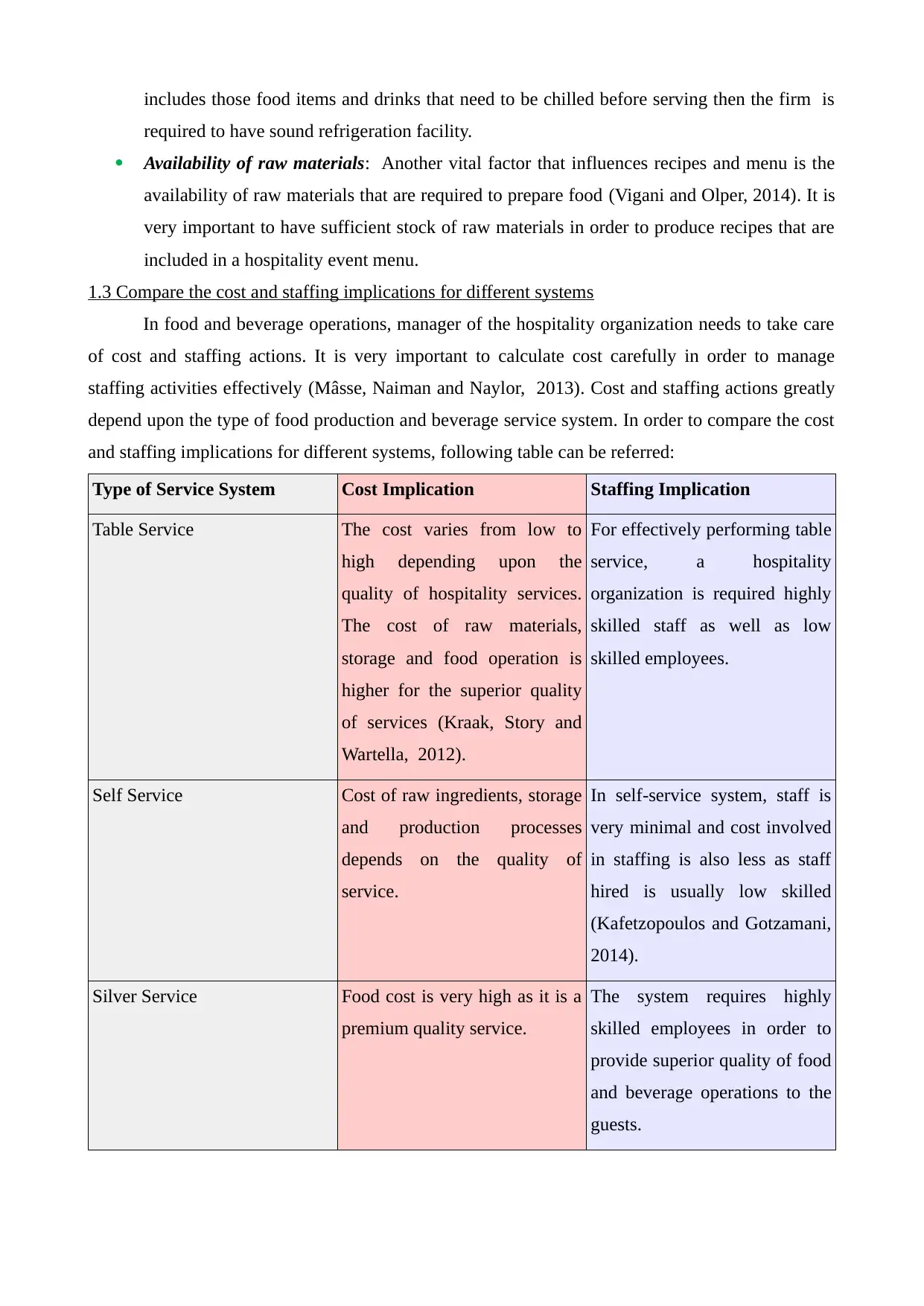
includes those food items and drinks that need to be chilled before serving then the firm is
required to have sound refrigeration facility.
Availability of raw materials: Another vital factor that influences recipes and menu is the
availability of raw materials that are required to prepare food (Vigani and Olper, 2014). It is
very important to have sufficient stock of raw materials in order to produce recipes that are
included in a hospitality event menu.
1.3 Compare the cost and staffing implications for different systems
In food and beverage operations, manager of the hospitality organization needs to take care
of cost and staffing actions. It is very important to calculate cost carefully in order to manage
staffing activities effectively (Mâsse, Naiman and Naylor, 2013). Cost and staffing actions greatly
depend upon the type of food production and beverage service system. In order to compare the cost
and staffing implications for different systems, following table can be referred:
Type of Service System Cost Implication Staffing Implication
Table Service The cost varies from low to
high depending upon the
quality of hospitality services.
The cost of raw materials,
storage and food operation is
higher for the superior quality
of services (Kraak, Story and
Wartella, 2012).
For effectively performing table
service, a hospitality
organization is required highly
skilled staff as well as low
skilled employees.
Self Service Cost of raw ingredients, storage
and production processes
depends on the quality of
service.
In self-service system, staff is
very minimal and cost involved
in staffing is also less as staff
hired is usually low skilled
(Kafetzopoulos and Gotzamani,
2014).
Silver Service Food cost is very high as it is a
premium quality service.
The system requires highly
skilled employees in order to
provide superior quality of food
and beverage operations to the
guests.
required to have sound refrigeration facility.
Availability of raw materials: Another vital factor that influences recipes and menu is the
availability of raw materials that are required to prepare food (Vigani and Olper, 2014). It is
very important to have sufficient stock of raw materials in order to produce recipes that are
included in a hospitality event menu.
1.3 Compare the cost and staffing implications for different systems
In food and beverage operations, manager of the hospitality organization needs to take care
of cost and staffing actions. It is very important to calculate cost carefully in order to manage
staffing activities effectively (Mâsse, Naiman and Naylor, 2013). Cost and staffing actions greatly
depend upon the type of food production and beverage service system. In order to compare the cost
and staffing implications for different systems, following table can be referred:
Type of Service System Cost Implication Staffing Implication
Table Service The cost varies from low to
high depending upon the
quality of hospitality services.
The cost of raw materials,
storage and food operation is
higher for the superior quality
of services (Kraak, Story and
Wartella, 2012).
For effectively performing table
service, a hospitality
organization is required highly
skilled staff as well as low
skilled employees.
Self Service Cost of raw ingredients, storage
and production processes
depends on the quality of
service.
In self-service system, staff is
very minimal and cost involved
in staffing is also less as staff
hired is usually low skilled
(Kafetzopoulos and Gotzamani,
2014).
Silver Service Food cost is very high as it is a
premium quality service.
The system requires highly
skilled employees in order to
provide superior quality of food
and beverage operations to the
guests.

1.4 Justify the suitability of systems for particular food and beverage outlets
According to the given scenario, the buffet service system is suitable and convenient for
hosting a term end celebration party. It can be justified that buffet include self service system in
which variety of recipes and drinks can be placed on a table so that guests can have food of their
choice. In the given case, the guest list include individuals with varied tastes and health concerns
such vegetarians, kids and diabetic people (Julia, Ducrot and Kesse-Guyot, 2015). The self service
system is also functional in this case as the food for vegetarian and diabetic people can be labelled
and presented separately on the table. For diabetic people the label that states “sugar free food” can
be used. Similarly for vegetarian food lovers the label stating “ vegetarian food” can be used. In
addition to this, the food and beverages can be presented in attractive and clean serving dishes and
glasswares to attract guests and to enhance their dining experience. Apart from this the cost and
staffing required in this system is also economical.
TASK B
2.1Discuss the use of financial statements in food and beverage operations
Financial statement can be explained as the financial status of an hospitality organization
and is also referred to a record of all financial actions of business operations. The financial
statement is broadly categorized into various types. These include income statement, balance sheet,
operating statement, sales record, variance analysis, etc (Herschdoerfer, 2012). The use of financial
statements in food and beverage operations in the given scenario can be discussed in the following
points: Cost Statement: It entails all the direct as well as indirect costs that are incurred in the food
and beverage operations (Food and Beverage Journal, 2016). The statement is useful in
allocation of budget for hosting the party in the given scenario. Operating Statement: the statement is useful in presenting the final preparation cost in food
and beverage operations. The operating statement in the give scenario will include the
procurement cost of raw materials and cost related to food preparation as well as its
presentation. Dish Costing Sheet: It is useful in calculating the selling price of a recipe or menu. In this
sheet the cost of every raw ingredient is calculated with the help of costing statement
(Harrison, Jennings and Cassidy, 2013). This sheet is very useful for the manager of the pub
in selecting recipes to be included in the menu of the term end party in the given case.
Variance Analysis: It is very useful in comparing actual costs of food items and planned
budget in order to to evaluate them. Variance analysis is used by the manager of the pub to
control the prices of recipes that included in the party menu and make sure that prices
remain within agreed budget.
According to the given scenario, the buffet service system is suitable and convenient for
hosting a term end celebration party. It can be justified that buffet include self service system in
which variety of recipes and drinks can be placed on a table so that guests can have food of their
choice. In the given case, the guest list include individuals with varied tastes and health concerns
such vegetarians, kids and diabetic people (Julia, Ducrot and Kesse-Guyot, 2015). The self service
system is also functional in this case as the food for vegetarian and diabetic people can be labelled
and presented separately on the table. For diabetic people the label that states “sugar free food” can
be used. Similarly for vegetarian food lovers the label stating “ vegetarian food” can be used. In
addition to this, the food and beverages can be presented in attractive and clean serving dishes and
glasswares to attract guests and to enhance their dining experience. Apart from this the cost and
staffing required in this system is also economical.
TASK B
2.1Discuss the use of financial statements in food and beverage operations
Financial statement can be explained as the financial status of an hospitality organization
and is also referred to a record of all financial actions of business operations. The financial
statement is broadly categorized into various types. These include income statement, balance sheet,
operating statement, sales record, variance analysis, etc (Herschdoerfer, 2012). The use of financial
statements in food and beverage operations in the given scenario can be discussed in the following
points: Cost Statement: It entails all the direct as well as indirect costs that are incurred in the food
and beverage operations (Food and Beverage Journal, 2016). The statement is useful in
allocation of budget for hosting the party in the given scenario. Operating Statement: the statement is useful in presenting the final preparation cost in food
and beverage operations. The operating statement in the give scenario will include the
procurement cost of raw materials and cost related to food preparation as well as its
presentation. Dish Costing Sheet: It is useful in calculating the selling price of a recipe or menu. In this
sheet the cost of every raw ingredient is calculated with the help of costing statement
(Harrison, Jennings and Cassidy, 2013). This sheet is very useful for the manager of the pub
in selecting recipes to be included in the menu of the term end party in the given case.
Variance Analysis: It is very useful in comparing actual costs of food items and planned
budget in order to to evaluate them. Variance analysis is used by the manager of the pub to
control the prices of recipes that included in the party menu and make sure that prices
remain within agreed budget.
⊘ This is a preview!⊘
Do you want full access?
Subscribe today to unlock all pages.

Trusted by 1+ million students worldwide
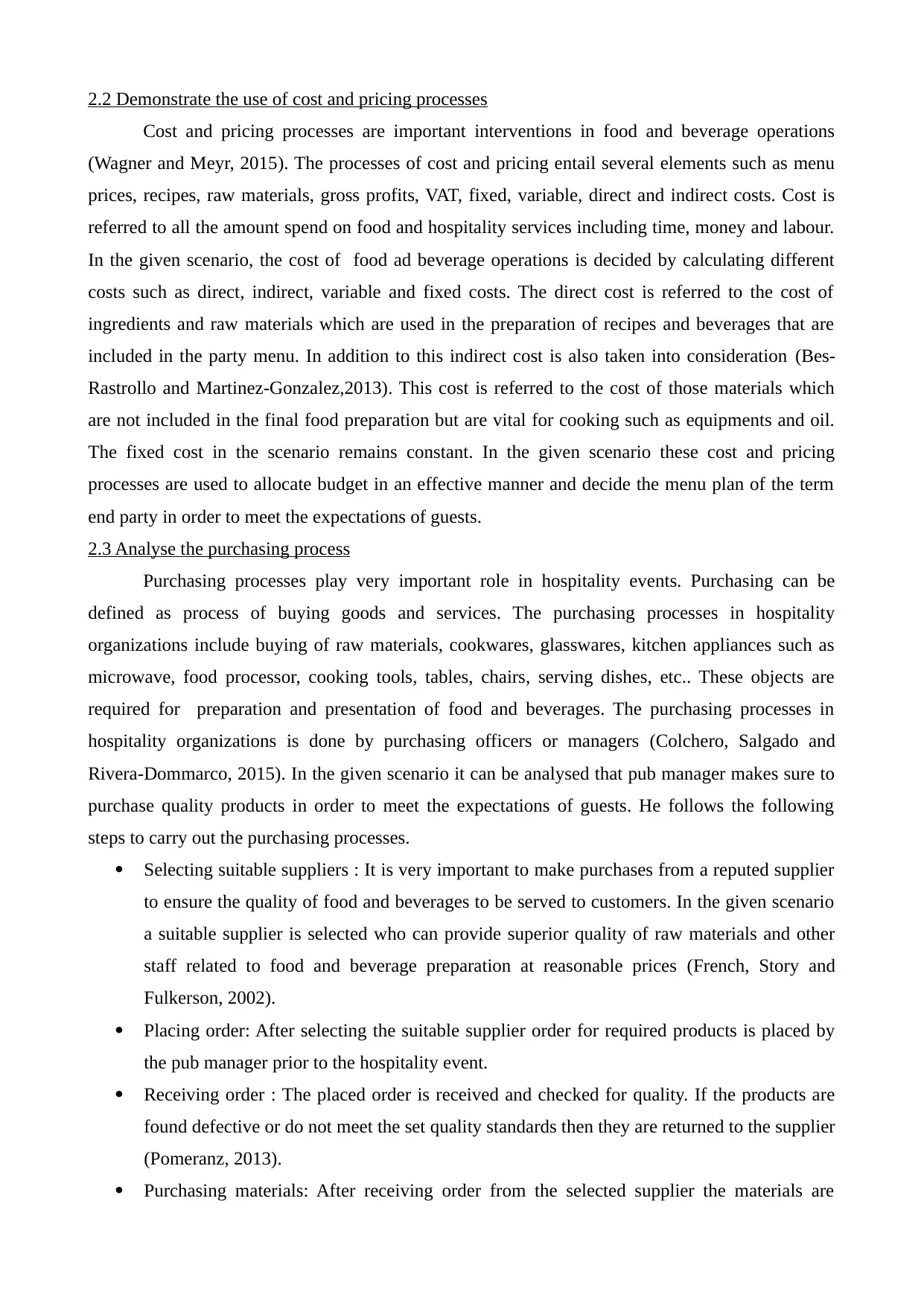
2.2 Demonstrate the use of cost and pricing processes
Cost and pricing processes are important interventions in food and beverage operations
(Wagner and Meyr, 2015). The processes of cost and pricing entail several elements such as menu
prices, recipes, raw materials, gross profits, VAT, fixed, variable, direct and indirect costs. Cost is
referred to all the amount spend on food and hospitality services including time, money and labour.
In the given scenario, the cost of food ad beverage operations is decided by calculating different
costs such as direct, indirect, variable and fixed costs. The direct cost is referred to the cost of
ingredients and raw materials which are used in the preparation of recipes and beverages that are
included in the party menu. In addition to this indirect cost is also taken into consideration (Bes-
Rastrollo and Martinez-Gonzalez,2013). This cost is referred to the cost of those materials which
are not included in the final food preparation but are vital for cooking such as equipments and oil.
The fixed cost in the scenario remains constant. In the given scenario these cost and pricing
processes are used to allocate budget in an effective manner and decide the menu plan of the term
end party in order to meet the expectations of guests.
2.3 Analyse the purchasing process
Purchasing processes play very important role in hospitality events. Purchasing can be
defined as process of buying goods and services. The purchasing processes in hospitality
organizations include buying of raw materials, cookwares, glasswares, kitchen appliances such as
microwave, food processor, cooking tools, tables, chairs, serving dishes, etc.. These objects are
required for preparation and presentation of food and beverages. The purchasing processes in
hospitality organizations is done by purchasing officers or managers (Colchero, Salgado and
Rivera-Dommarco, 2015). In the given scenario it can be analysed that pub manager makes sure to
purchase quality products in order to meet the expectations of guests. He follows the following
steps to carry out the purchasing processes.
Selecting suitable suppliers : It is very important to make purchases from a reputed supplier
to ensure the quality of food and beverages to be served to customers. In the given scenario
a suitable supplier is selected who can provide superior quality of raw materials and other
staff related to food and beverage preparation at reasonable prices (French, Story and
Fulkerson, 2002).
Placing order: After selecting the suitable supplier order for required products is placed by
the pub manager prior to the hospitality event.
Receiving order : The placed order is received and checked for quality. If the products are
found defective or do not meet the set quality standards then they are returned to the supplier
(Pomeranz, 2013).
Purchasing materials: After receiving order from the selected supplier the materials are
Cost and pricing processes are important interventions in food and beverage operations
(Wagner and Meyr, 2015). The processes of cost and pricing entail several elements such as menu
prices, recipes, raw materials, gross profits, VAT, fixed, variable, direct and indirect costs. Cost is
referred to all the amount spend on food and hospitality services including time, money and labour.
In the given scenario, the cost of food ad beverage operations is decided by calculating different
costs such as direct, indirect, variable and fixed costs. The direct cost is referred to the cost of
ingredients and raw materials which are used in the preparation of recipes and beverages that are
included in the party menu. In addition to this indirect cost is also taken into consideration (Bes-
Rastrollo and Martinez-Gonzalez,2013). This cost is referred to the cost of those materials which
are not included in the final food preparation but are vital for cooking such as equipments and oil.
The fixed cost in the scenario remains constant. In the given scenario these cost and pricing
processes are used to allocate budget in an effective manner and decide the menu plan of the term
end party in order to meet the expectations of guests.
2.3 Analyse the purchasing process
Purchasing processes play very important role in hospitality events. Purchasing can be
defined as process of buying goods and services. The purchasing processes in hospitality
organizations include buying of raw materials, cookwares, glasswares, kitchen appliances such as
microwave, food processor, cooking tools, tables, chairs, serving dishes, etc.. These objects are
required for preparation and presentation of food and beverages. The purchasing processes in
hospitality organizations is done by purchasing officers or managers (Colchero, Salgado and
Rivera-Dommarco, 2015). In the given scenario it can be analysed that pub manager makes sure to
purchase quality products in order to meet the expectations of guests. He follows the following
steps to carry out the purchasing processes.
Selecting suitable suppliers : It is very important to make purchases from a reputed supplier
to ensure the quality of food and beverages to be served to customers. In the given scenario
a suitable supplier is selected who can provide superior quality of raw materials and other
staff related to food and beverage preparation at reasonable prices (French, Story and
Fulkerson, 2002).
Placing order: After selecting the suitable supplier order for required products is placed by
the pub manager prior to the hospitality event.
Receiving order : The placed order is received and checked for quality. If the products are
found defective or do not meet the set quality standards then they are returned to the supplier
(Pomeranz, 2013).
Purchasing materials: After receiving order from the selected supplier the materials are
Paraphrase This Document
Need a fresh take? Get an instant paraphrase of this document with our AI Paraphraser
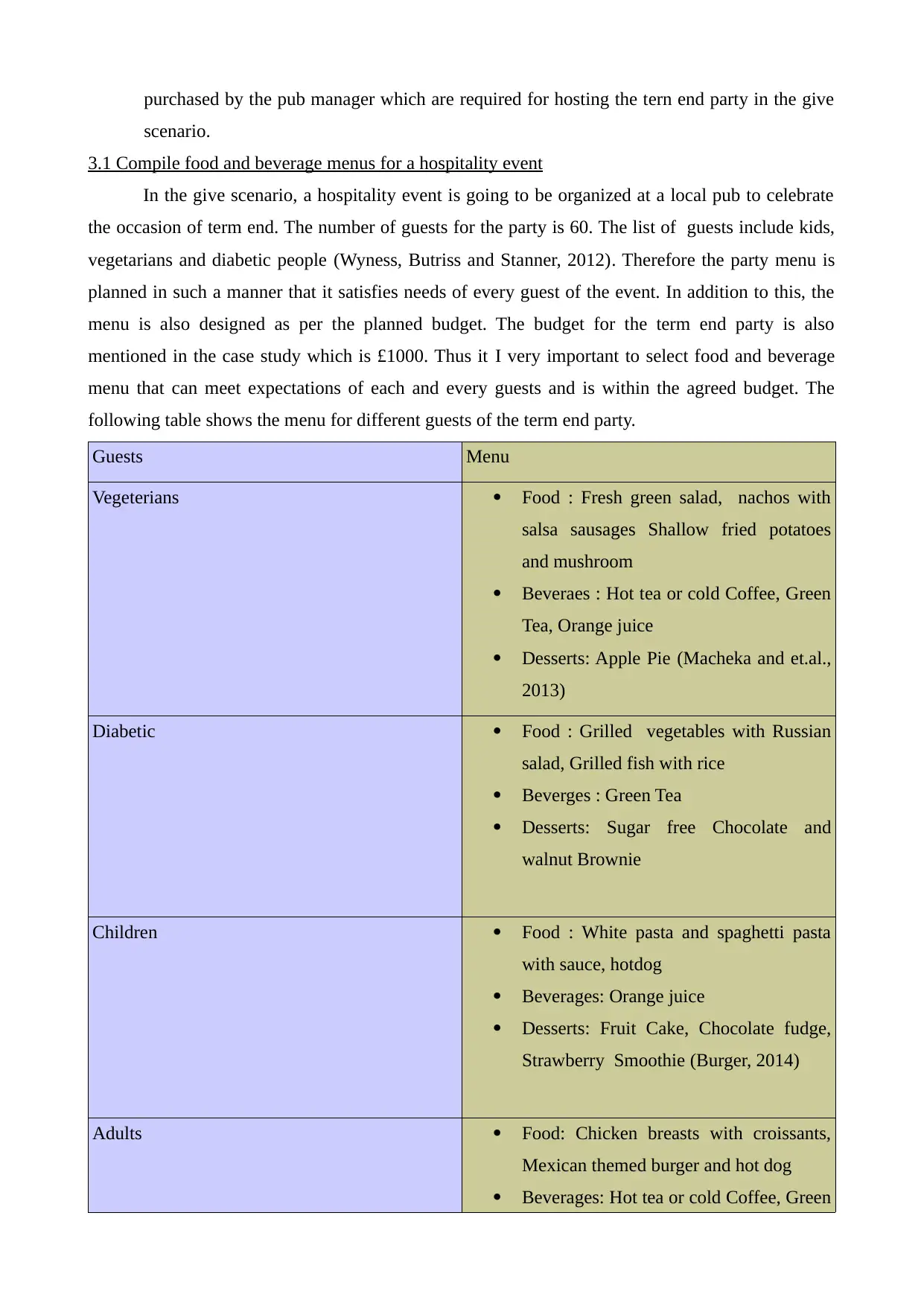
purchased by the pub manager which are required for hosting the tern end party in the give
scenario.
3.1 Compile food and beverage menus for a hospitality event
In the give scenario, a hospitality event is going to be organized at a local pub to celebrate
the occasion of term end. The number of guests for the party is 60. The list of guests include kids,
vegetarians and diabetic people (Wyness, Butriss and Stanner, 2012). Therefore the party menu is
planned in such a manner that it satisfies needs of every guest of the event. In addition to this, the
menu is also designed as per the planned budget. The budget for the term end party is also
mentioned in the case study which is £1000. Thus it I very important to select food and beverage
menu that can meet expectations of each and every guests and is within the agreed budget. The
following table shows the menu for different guests of the term end party.
Guests Menu
Vegeterians Food : Fresh green salad, nachos with
salsa sausages Shallow fried potatoes
and mushroom
Beveraes : Hot tea or cold Coffee, Green
Tea, Orange juice
Desserts: Apple Pie (Macheka and et.al.,
2013)
Diabetic Food : Grilled vegetables with Russian
salad, Grilled fish with rice
Beverges : Green Tea
Desserts: Sugar free Chocolate and
walnut Brownie
Children Food : White pasta and spaghetti pasta
with sauce, hotdog
Beverages: Orange juice
Desserts: Fruit Cake, Chocolate fudge,
Strawberry Smoothie (Burger, 2014)
Adults Food: Chicken breasts with croissants,
Mexican themed burger and hot dog
Beverages: Hot tea or cold Coffee, Green
scenario.
3.1 Compile food and beverage menus for a hospitality event
In the give scenario, a hospitality event is going to be organized at a local pub to celebrate
the occasion of term end. The number of guests for the party is 60. The list of guests include kids,
vegetarians and diabetic people (Wyness, Butriss and Stanner, 2012). Therefore the party menu is
planned in such a manner that it satisfies needs of every guest of the event. In addition to this, the
menu is also designed as per the planned budget. The budget for the term end party is also
mentioned in the case study which is £1000. Thus it I very important to select food and beverage
menu that can meet expectations of each and every guests and is within the agreed budget. The
following table shows the menu for different guests of the term end party.
Guests Menu
Vegeterians Food : Fresh green salad, nachos with
salsa sausages Shallow fried potatoes
and mushroom
Beveraes : Hot tea or cold Coffee, Green
Tea, Orange juice
Desserts: Apple Pie (Macheka and et.al.,
2013)
Diabetic Food : Grilled vegetables with Russian
salad, Grilled fish with rice
Beverges : Green Tea
Desserts: Sugar free Chocolate and
walnut Brownie
Children Food : White pasta and spaghetti pasta
with sauce, hotdog
Beverages: Orange juice
Desserts: Fruit Cake, Chocolate fudge,
Strawberry Smoothie (Burger, 2014)
Adults Food: Chicken breasts with croissants,
Mexican themed burger and hot dog
Beverages: Hot tea or cold Coffee, Green
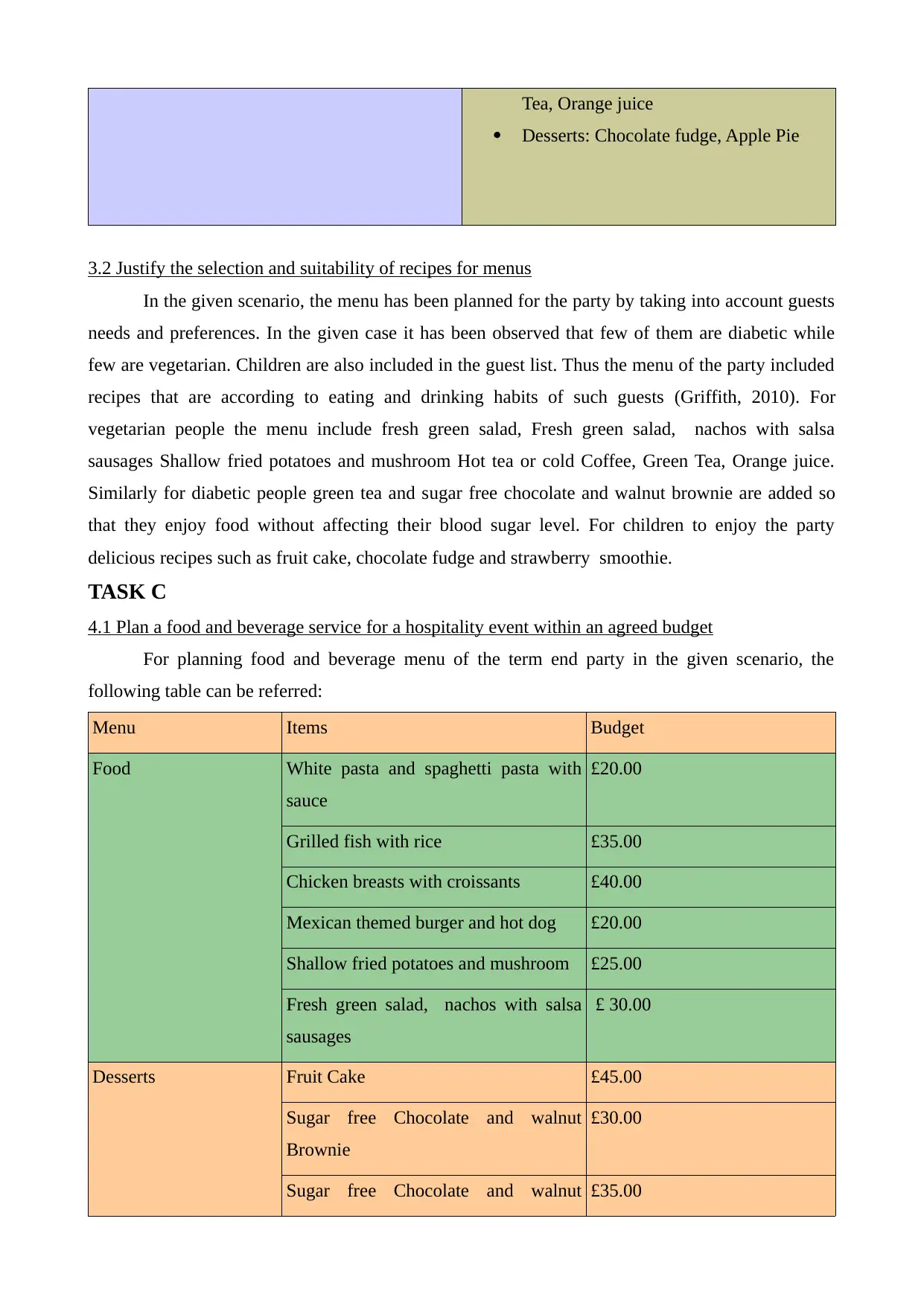
Tea, Orange juice
Desserts: Chocolate fudge, Apple Pie
3.2 Justify the selection and suitability of recipes for menus
In the given scenario, the menu has been planned for the party by taking into account guests
needs and preferences. In the given case it has been observed that few of them are diabetic while
few are vegetarian. Children are also included in the guest list. Thus the menu of the party included
recipes that are according to eating and drinking habits of such guests (Griffith, 2010). For
vegetarian people the menu include fresh green salad, Fresh green salad, nachos with salsa
sausages Shallow fried potatoes and mushroom Hot tea or cold Coffee, Green Tea, Orange juice.
Similarly for diabetic people green tea and sugar free chocolate and walnut brownie are added so
that they enjoy food without affecting their blood sugar level. For children to enjoy the party
delicious recipes such as fruit cake, chocolate fudge and strawberry smoothie.
TASK C
4.1 Plan a food and beverage service for a hospitality event within an agreed budget
For planning food and beverage menu of the term end party in the given scenario, the
following table can be referred:
Menu Items Budget
Food White pasta and spaghetti pasta with
sauce
£20.00
Grilled fish with rice £35.00
Chicken breasts with croissants £40.00
Mexican themed burger and hot dog £20.00
Shallow fried potatoes and mushroom £25.00
Fresh green salad, nachos with salsa
sausages
£ 30.00
Desserts Fruit Cake £45.00
Sugar free Chocolate and walnut
Brownie
£30.00
Sugar free Chocolate and walnut £35.00
Desserts: Chocolate fudge, Apple Pie
3.2 Justify the selection and suitability of recipes for menus
In the given scenario, the menu has been planned for the party by taking into account guests
needs and preferences. In the given case it has been observed that few of them are diabetic while
few are vegetarian. Children are also included in the guest list. Thus the menu of the party included
recipes that are according to eating and drinking habits of such guests (Griffith, 2010). For
vegetarian people the menu include fresh green salad, Fresh green salad, nachos with salsa
sausages Shallow fried potatoes and mushroom Hot tea or cold Coffee, Green Tea, Orange juice.
Similarly for diabetic people green tea and sugar free chocolate and walnut brownie are added so
that they enjoy food without affecting their blood sugar level. For children to enjoy the party
delicious recipes such as fruit cake, chocolate fudge and strawberry smoothie.
TASK C
4.1 Plan a food and beverage service for a hospitality event within an agreed budget
For planning food and beverage menu of the term end party in the given scenario, the
following table can be referred:
Menu Items Budget
Food White pasta and spaghetti pasta with
sauce
£20.00
Grilled fish with rice £35.00
Chicken breasts with croissants £40.00
Mexican themed burger and hot dog £20.00
Shallow fried potatoes and mushroom £25.00
Fresh green salad, nachos with salsa
sausages
£ 30.00
Desserts Fruit Cake £45.00
Sugar free Chocolate and walnut
Brownie
£30.00
Sugar free Chocolate and walnut £35.00
⊘ This is a preview!⊘
Do you want full access?
Subscribe today to unlock all pages.

Trusted by 1+ million students worldwide
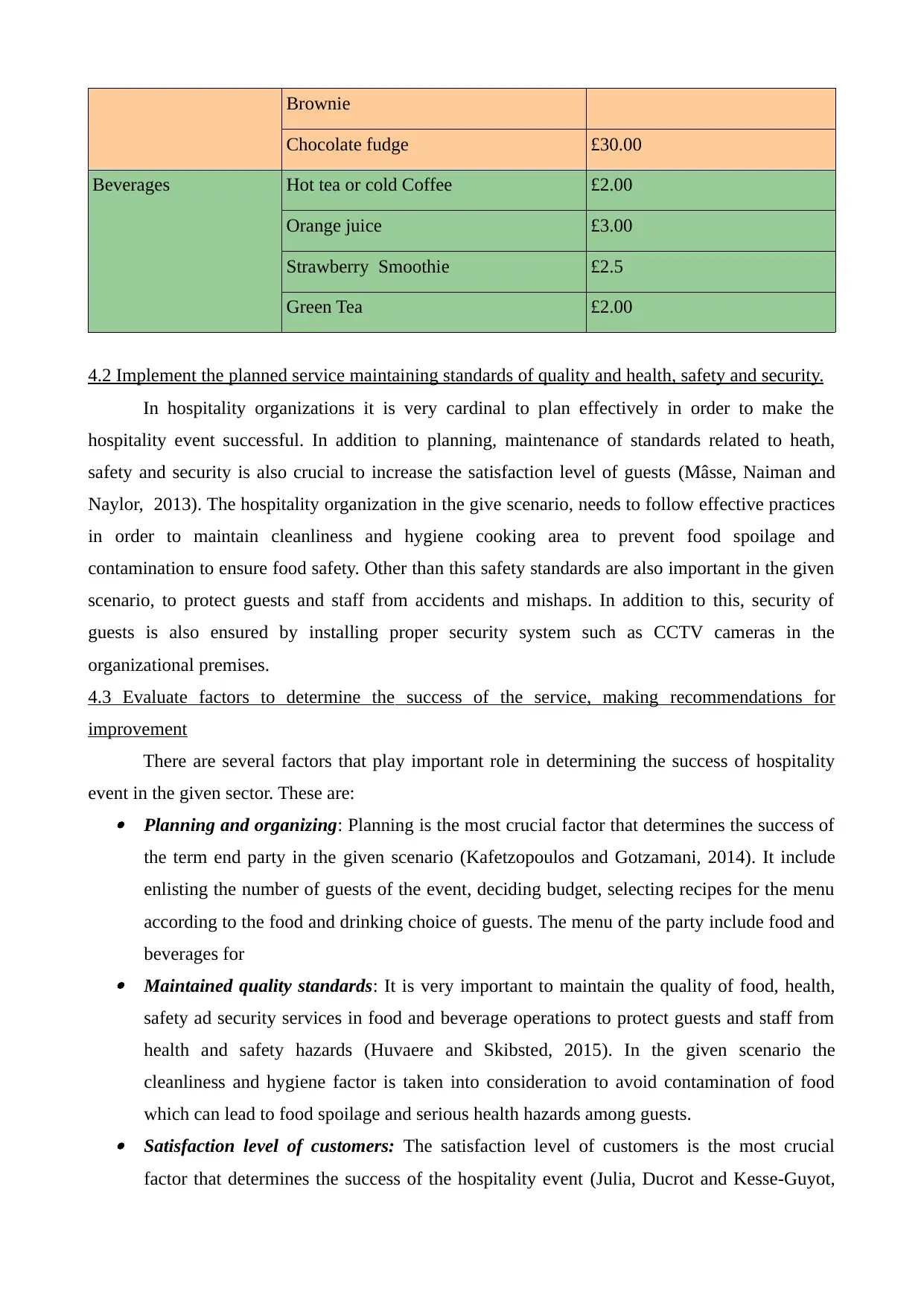
Brownie
Chocolate fudge £30.00
Beverages Hot tea or cold Coffee £2.00
Orange juice £3.00
Strawberry Smoothie £2.5
Green Tea £2.00
4.2 Implement the planned service maintaining standards of quality and health, safety and security.
In hospitality organizations it is very cardinal to plan effectively in order to make the
hospitality event successful. In addition to planning, maintenance of standards related to heath,
safety and security is also crucial to increase the satisfaction level of guests (Mâsse, Naiman and
Naylor, 2013). The hospitality organization in the give scenario, needs to follow effective practices
in order to maintain cleanliness and hygiene cooking area to prevent food spoilage and
contamination to ensure food safety. Other than this safety standards are also important in the given
scenario, to protect guests and staff from accidents and mishaps. In addition to this, security of
guests is also ensured by installing proper security system such as CCTV cameras in the
organizational premises.
4.3 Evaluate factors to determine the success of the service, making recommendations for
improvement
There are several factors that play important role in determining the success of hospitality
event in the given sector. These are: Planning and organizing: Planning is the most crucial factor that determines the success of
the term end party in the given scenario (Kafetzopoulos and Gotzamani, 2014). It include
enlisting the number of guests of the event, deciding budget, selecting recipes for the menu
according to the food and drinking choice of guests. The menu of the party include food and
beverages for Maintained quality standards: It is very important to maintain the quality of food, health,
safety ad security services in food and beverage operations to protect guests and staff from
health and safety hazards (Huvaere and Skibsted, 2015). In the given scenario the
cleanliness and hygiene factor is taken into consideration to avoid contamination of food
which can lead to food spoilage and serious health hazards among guests. Satisfaction level of customers: The satisfaction level of customers is the most crucial
factor that determines the success of the hospitality event (Julia, Ducrot and Kesse-Guyot,
Chocolate fudge £30.00
Beverages Hot tea or cold Coffee £2.00
Orange juice £3.00
Strawberry Smoothie £2.5
Green Tea £2.00
4.2 Implement the planned service maintaining standards of quality and health, safety and security.
In hospitality organizations it is very cardinal to plan effectively in order to make the
hospitality event successful. In addition to planning, maintenance of standards related to heath,
safety and security is also crucial to increase the satisfaction level of guests (Mâsse, Naiman and
Naylor, 2013). The hospitality organization in the give scenario, needs to follow effective practices
in order to maintain cleanliness and hygiene cooking area to prevent food spoilage and
contamination to ensure food safety. Other than this safety standards are also important in the given
scenario, to protect guests and staff from accidents and mishaps. In addition to this, security of
guests is also ensured by installing proper security system such as CCTV cameras in the
organizational premises.
4.3 Evaluate factors to determine the success of the service, making recommendations for
improvement
There are several factors that play important role in determining the success of hospitality
event in the given sector. These are: Planning and organizing: Planning is the most crucial factor that determines the success of
the term end party in the given scenario (Kafetzopoulos and Gotzamani, 2014). It include
enlisting the number of guests of the event, deciding budget, selecting recipes for the menu
according to the food and drinking choice of guests. The menu of the party include food and
beverages for Maintained quality standards: It is very important to maintain the quality of food, health,
safety ad security services in food and beverage operations to protect guests and staff from
health and safety hazards (Huvaere and Skibsted, 2015). In the given scenario the
cleanliness and hygiene factor is taken into consideration to avoid contamination of food
which can lead to food spoilage and serious health hazards among guests. Satisfaction level of customers: The satisfaction level of customers is the most crucial
factor that determines the success of the hospitality event (Julia, Ducrot and Kesse-Guyot,
Paraphrase This Document
Need a fresh take? Get an instant paraphrase of this document with our AI Paraphraser

2015). It can be evaluated that all the guests of the term end party may relish the food and
beverages presented in the buffet system the menu is planed in such a manner that it can
satisfy the needs of all guests including vegetarians, kids, adults and diabetic people.
Recommendations
In order to ameliorate the quality of the food and beverage operations, the cooking and
serving staff of the pub can be trained effectively (Burger, 2014).
The cooking equipment need to be checked on regular intervals to avoid any mishap.
The purchasing processes can be made more effective by selecting good suppliers.
CONCLUSION
In a nutshell, food and beverage operations are important for the success of an hospitality
event. From the above report it has been learned that financial controls is very important in food and
beverage operations. In addition to this characteristics of food production and beverage service
system are also learned. The research studies various factors that affect recipes and menus for
specific systems.
beverages presented in the buffet system the menu is planed in such a manner that it can
satisfy the needs of all guests including vegetarians, kids, adults and diabetic people.
Recommendations
In order to ameliorate the quality of the food and beverage operations, the cooking and
serving staff of the pub can be trained effectively (Burger, 2014).
The cooking equipment need to be checked on regular intervals to avoid any mishap.
The purchasing processes can be made more effective by selecting good suppliers.
CONCLUSION
In a nutshell, food and beverage operations are important for the success of an hospitality
event. From the above report it has been learned that financial controls is very important in food and
beverage operations. In addition to this characteristics of food production and beverage service
system are also learned. The research studies various factors that affect recipes and menus for
specific systems.
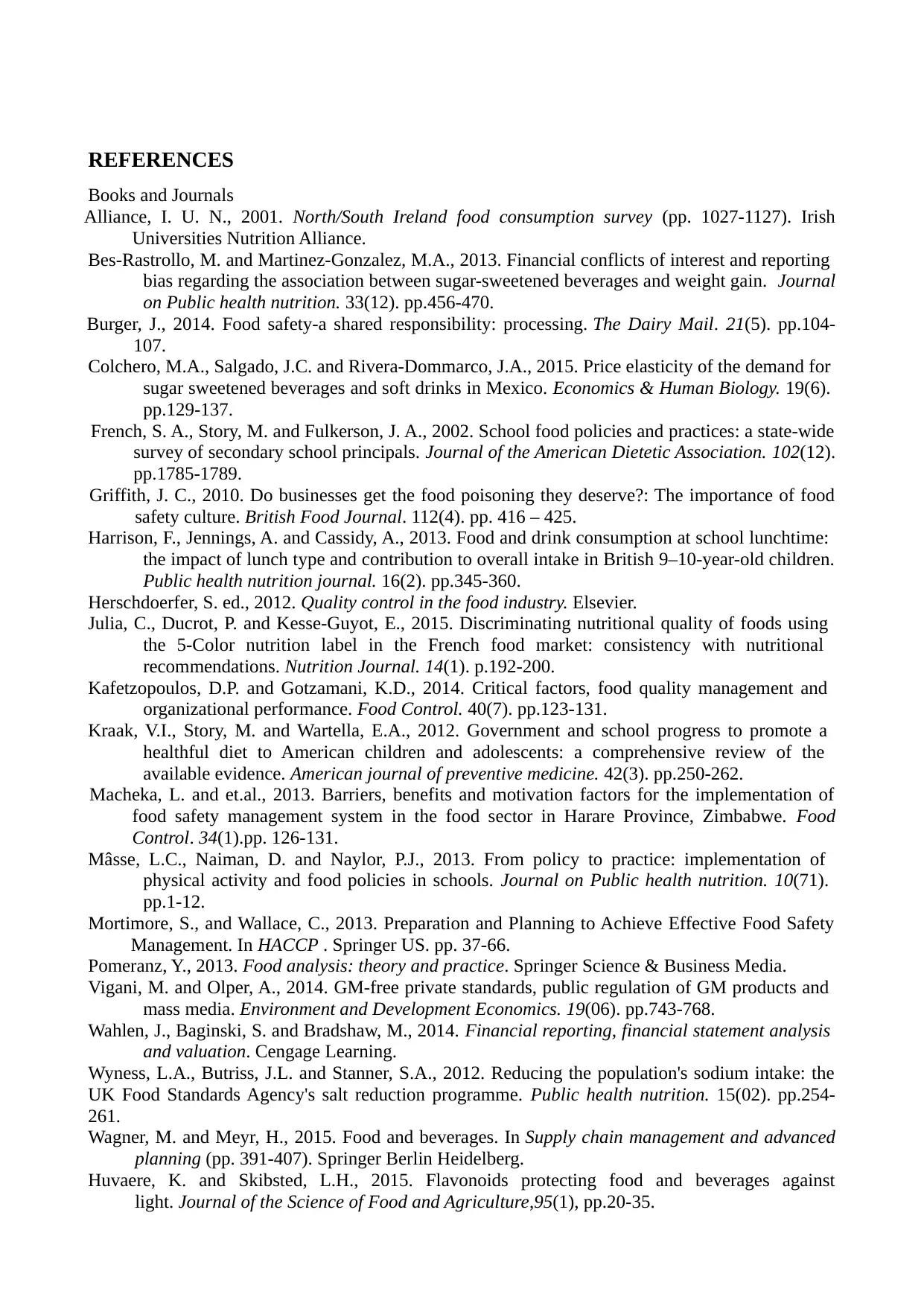
REFERENCES
Books and Journals
Alliance, I. U. N., 2001. North/South Ireland food consumption survey (pp. 1027-1127). Irish
Universities Nutrition Alliance.
Bes-Rastrollo, M. and Martinez-Gonzalez, M.A., 2013. Financial conflicts of interest and reporting
bias regarding the association between sugar-sweetened beverages and weight gain. Journal
on Public health nutrition. 33(12). pp.456-470.
Burger, J., 2014. Food safety-a shared responsibility: processing. The Dairy Mail. 21(5). pp.104-
107.
Colchero, M.A., Salgado, J.C. and Rivera-Dommarco, J.A., 2015. Price elasticity of the demand for
sugar sweetened beverages and soft drinks in Mexico. Economics & Human Biology. 19(6).
pp.129-137.
French, S. A., Story, M. and Fulkerson, J. A., 2002. School food policies and practices: a state-wide
survey of secondary school principals. Journal of the American Dietetic Association. 102(12).
pp.1785-1789.
Griffith, J. C., 2010. Do businesses get the food poisoning they deserve?: The importance of food
safety culture. British Food Journal. 112(4). pp. 416 – 425.
Harrison, F., Jennings, A. and Cassidy, A., 2013. Food and drink consumption at school lunchtime:
the impact of lunch type and contribution to overall intake in British 9–10-year-old children.
Public health nutrition journal. 16(2). pp.345-360.
Herschdoerfer, S. ed., 2012. Quality control in the food industry. Elsevier.
Julia, C., Ducrot, P. and Kesse-Guyot, E., 2015. Discriminating nutritional quality of foods using
the 5-Color nutrition label in the French food market: consistency with nutritional
recommendations. Nutrition Journal. 14(1). p.192-200.
Kafetzopoulos, D.P. and Gotzamani, K.D., 2014. Critical factors, food quality management and
organizational performance. Food Control. 40(7). pp.123-131.
Kraak, V.I., Story, M. and Wartella, E.A., 2012. Government and school progress to promote a
healthful diet to American children and adolescents: a comprehensive review of the
available evidence. American journal of preventive medicine. 42(3). pp.250-262.
Macheka, L. and et.al., 2013. Barriers, benefits and motivation factors for the implementation of
food safety management system in the food sector in Harare Province, Zimbabwe. Food
Control. 34(1).pp. 126-131.
Mâsse, L.C., Naiman, D. and Naylor, P.J., 2013. From policy to practice: implementation of
physical activity and food policies in schools. Journal on Public health nutrition. 10(71).
pp.1-12.
Mortimore, S., and Wallace, C., 2013. Preparation and Planning to Achieve Effective Food Safety
Management. In HACCP . Springer US. pp. 37-66.
Pomeranz, Y., 2013. Food analysis: theory and practice. Springer Science & Business Media.
Vigani, M. and Olper, A., 2014. GM-free private standards, public regulation of GM products and
mass media. Environment and Development Economics. 19(06). pp.743-768.
Wahlen, J., Baginski, S. and Bradshaw, M., 2014. Financial reporting, financial statement analysis
and valuation. Cengage Learning.
Wyness, L.A., Butriss, J.L. and Stanner, S.A., 2012. Reducing the population's sodium intake: the
UK Food Standards Agency's salt reduction programme. Public health nutrition. 15(02). pp.254-
261.
Wagner, M. and Meyr, H., 2015. Food and beverages. In Supply chain management and advanced
planning (pp. 391-407). Springer Berlin Heidelberg.
Huvaere, K. and Skibsted, L.H., 2015. Flavonoids protecting food and beverages against
light. Journal of the Science of Food and Agriculture,95(1), pp.20-35.
Books and Journals
Alliance, I. U. N., 2001. North/South Ireland food consumption survey (pp. 1027-1127). Irish
Universities Nutrition Alliance.
Bes-Rastrollo, M. and Martinez-Gonzalez, M.A., 2013. Financial conflicts of interest and reporting
bias regarding the association between sugar-sweetened beverages and weight gain. Journal
on Public health nutrition. 33(12). pp.456-470.
Burger, J., 2014. Food safety-a shared responsibility: processing. The Dairy Mail. 21(5). pp.104-
107.
Colchero, M.A., Salgado, J.C. and Rivera-Dommarco, J.A., 2015. Price elasticity of the demand for
sugar sweetened beverages and soft drinks in Mexico. Economics & Human Biology. 19(6).
pp.129-137.
French, S. A., Story, M. and Fulkerson, J. A., 2002. School food policies and practices: a state-wide
survey of secondary school principals. Journal of the American Dietetic Association. 102(12).
pp.1785-1789.
Griffith, J. C., 2010. Do businesses get the food poisoning they deserve?: The importance of food
safety culture. British Food Journal. 112(4). pp. 416 – 425.
Harrison, F., Jennings, A. and Cassidy, A., 2013. Food and drink consumption at school lunchtime:
the impact of lunch type and contribution to overall intake in British 9–10-year-old children.
Public health nutrition journal. 16(2). pp.345-360.
Herschdoerfer, S. ed., 2012. Quality control in the food industry. Elsevier.
Julia, C., Ducrot, P. and Kesse-Guyot, E., 2015. Discriminating nutritional quality of foods using
the 5-Color nutrition label in the French food market: consistency with nutritional
recommendations. Nutrition Journal. 14(1). p.192-200.
Kafetzopoulos, D.P. and Gotzamani, K.D., 2014. Critical factors, food quality management and
organizational performance. Food Control. 40(7). pp.123-131.
Kraak, V.I., Story, M. and Wartella, E.A., 2012. Government and school progress to promote a
healthful diet to American children and adolescents: a comprehensive review of the
available evidence. American journal of preventive medicine. 42(3). pp.250-262.
Macheka, L. and et.al., 2013. Barriers, benefits and motivation factors for the implementation of
food safety management system in the food sector in Harare Province, Zimbabwe. Food
Control. 34(1).pp. 126-131.
Mâsse, L.C., Naiman, D. and Naylor, P.J., 2013. From policy to practice: implementation of
physical activity and food policies in schools. Journal on Public health nutrition. 10(71).
pp.1-12.
Mortimore, S., and Wallace, C., 2013. Preparation and Planning to Achieve Effective Food Safety
Management. In HACCP . Springer US. pp. 37-66.
Pomeranz, Y., 2013. Food analysis: theory and practice. Springer Science & Business Media.
Vigani, M. and Olper, A., 2014. GM-free private standards, public regulation of GM products and
mass media. Environment and Development Economics. 19(06). pp.743-768.
Wahlen, J., Baginski, S. and Bradshaw, M., 2014. Financial reporting, financial statement analysis
and valuation. Cengage Learning.
Wyness, L.A., Butriss, J.L. and Stanner, S.A., 2012. Reducing the population's sodium intake: the
UK Food Standards Agency's salt reduction programme. Public health nutrition. 15(02). pp.254-
261.
Wagner, M. and Meyr, H., 2015. Food and beverages. In Supply chain management and advanced
planning (pp. 391-407). Springer Berlin Heidelberg.
Huvaere, K. and Skibsted, L.H., 2015. Flavonoids protecting food and beverages against
light. Journal of the Science of Food and Agriculture,95(1), pp.20-35.
⊘ This is a preview!⊘
Do you want full access?
Subscribe today to unlock all pages.

Trusted by 1+ million students worldwide
1 out of 13
Related Documents
Your All-in-One AI-Powered Toolkit for Academic Success.
+13062052269
info@desklib.com
Available 24*7 on WhatsApp / Email
![[object Object]](/_next/static/media/star-bottom.7253800d.svg)
Unlock your academic potential
Copyright © 2020–2025 A2Z Services. All Rights Reserved. Developed and managed by ZUCOL.





